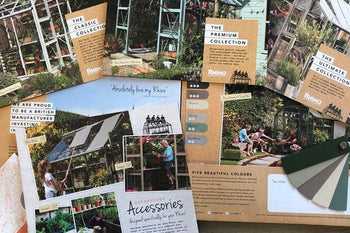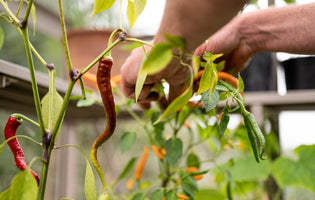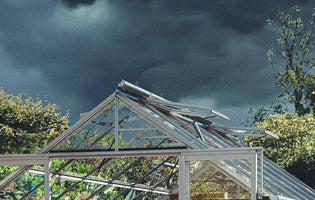Each year I forget that February is generally our coldest winter month with snow and freezing; and this year certainly isn’t disappointing us on that front. The pots in my makeshift cold frame have frozen and the heater in the Rhino is working so hard it's shorting out the washing machine. During the day I'm having to wait for greenhouse temperatures to rise before I put the machine on. It’s a choice between clean clothes or happy plants I'm afraid. I am very glad that we have circuit breakers on our fuse board though, otherwise fuses would be blowing.
This cold snap is giving me a good chance to take a look at what needs doing with my roses.
How to Prune Young Rose Bushes (max 2 years)
How to Prune Established Rose Bushes (2+ years)
I have found rose pruning quite tricky and have never been quite comfortable about my approach, gleaned from years of reading a plethora of books and asking rose growers - until now. Diagrams in books, with red crosses on stems, also look very confusing. As a result, my approach has ranged from, haphazard, to a brutal - one size fits all - chop off at the knees. I can assure you that this no longer happens; and as I now wish to grow lots of beautiful blooms I am adopting a much gentler approach which seems far more appropriate. It also seems to work and I am much happier with it. I often find that gardening and growing is about finding what works for you, because no two gardens or gardeners are the same, and we never stop learning, we are forever refining our techniques.
So far this winter I haven't really touched the roses apart from reducing stems to prevent wind rock, cutting off dead blooms, tying a few stems onto some wires, and mulching to protect them from the ravages of winter.
Over the years, I have invested in a number of David Austin roses. I adore them. They are so romantic and beautiful, I can't resist them - with names from the novels of Thomas Hardy, which I grew up on (to be honest who didn’t?). But living in North Dorset we knew those highways and byways that he wrote about, and they still fill me with nostalgia, and memories of chalk downs, harebells, fragrant gorse and summer days.
It is no secret, but I am now following the advice of the head gardener, Steve, at David Austin Roses, who has a gentle and straight forward approach to pruning roses, which encourages them to flourish. Videos are available on YouTube if you’d like to look him up for yourself.
Pruning Roses:
When to prune:
- Prune on days that are above freezing between now (February) and end of March.
- Prune before the leaves start sprouting so that the plant's energy is not being wasted.
One year old roses:

Young rose bush after pruning
- For pruning, you need a 40cm long stick, clean secateurs, gloves, bucket.
- At the rose bush push the stick into the ground 10cm.
- This is your marker as you will now cut all stems to a height of 30cm. Put the cuttings into the bucket.
- Now cut off any dead stems or thin wispy stems that aren’t going to be strong enough to hold a bloom.
- If you have any stems that are crossing and rubbing each other, you may need to cut one off to prevent damage.
- Clear off any leaves and hips remaining on the plant and put in the bucket.
You should end up with a 30cm high shrub with strong looking stems with a good clean airy structure.
Established Rose Shrubs:
- These are shrubs that have been in the ground for two to twenty years or more.
- For pruning you need a tape measure, a 1.5 meter long stick, clean secateurs, gloves, bucket
- At the rose bush push the stick into the ground and mark half the height of the rose bush.
- This is your mark as you will now cut all stems to half the height of the shrub. Put the cuttings into the bucket.
- Now cut out any dead or diseased stems, and thin wispy stems that aren’t going to be strong enough to hold a bloom.
- If you have any stems that are crossing and rubbing each other, you may need to cut one off to prevent damage.
- Clear off any leaves and hips remaining on the plant and put in the bucket.
You should end up with a shrub with clean stems and a good airy structure ready for some good strong growth.
Climbing Roses:

Teasing Georgia on the wall with Japanese Anemone
- These roses can be trained on wires up and along walls around the house and garden.
- For pruning you will need soft wire, clean secateurs, gloves, bucket.
- Make sure your main training wires are secure.
- Familiarize yourself with the main stems which form the structure of the rose. If they crisscross over each other make sure they aren't rubbing as this can cause damage to the plant. Any stems rubbing against each other will need to be removed.
- For each main stem, take off any side shoots to two or three inches. These are going to form your flowering stems.
- Cut off any dead or diseased stems, and thin wispy stems that aren’t going to be strong enough to hold a bloom.
- If you have any new main stems growing, tie them in and bend them to provide a little stress. This will encourage flowering shoots to grow from the stem.
- As the plant grows, you can also tie and lightly stress bend any new stems that grow and this will form a tapestry of stems that then produce flowers.
- Clear off any leaves and hips remaining on the plant and put in the bucket.
Weeding and Clearing Ground:
- Weed around the plants to a diameter of about 60cm. Roses don’t like competition and they do like clear air.
- Don’t leave any cut stems or leaves on the ground as they may harbor disease. Dispose of them to the bin.
Companion Planting:
- Salvias and Sage (same family) contain sulfur which can help with controlling black spot without the use of chemicals.
- Start sowing Salvias indoors. These will be planted into the rose beds to help with controlling black spot and mildew.
- Consider planting some sage cuttings too.
Mulching and Feeding:
- Add mulch around the base of the roses and dig in lightly, but keep the stems clear.
- Feed again with rose feed in the spring as sprouting starts.
Aphids:
- Aphids can be quite partial to a tender rose buds in June and July.
- Don the marigolds and start squishing and removing. Wash off with a light solution of washing up liquid mixed into a bottle of water.
Propagation:
- Try propagating more rose shrubs with some of the strong healthy stems pruned from the roses.
- Fill a nine inch pot with cutting compost or potting compost with gravel mixed in, for drainage.
- clean the bottom leaves off the stems apart from two towards the top.
- dip the bottom of the stem in rooting hormone powder, or talcum powder. If not available, don’t worry.
- Place the stems into the compost, around the edge of the pot.
- Water lightly and place pot into a sheltered spot in a greenhouse or corner of garden.
- Leave for a few months and check for any root growth.
- If there is root growth, pot on into potting compost.
Happy rose growing.

Sarah in a flower jar with poppies, alliums, daucus, cosmos and marjoram
If you'd like to find out more about La-Di Dardy Flowers, you can find them on Instagram or go to https://www.flowersfromthefarm.co.uk/members/la-di-dardy-flowers
Updated - December 14, 2022
Published - February 12, 2021







